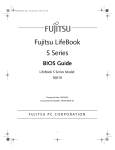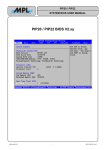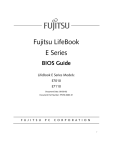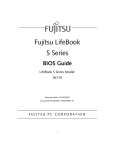Download Fujitsu C1320D User's Manual
Transcript
Fujitsu LifeBook
C Series
BIOS Guide
LifeBook C Series Model:
C1320D
Document Date: 09/06/2005
Document Part Number: FPC58-1401-01
FUJITSU COMPUTER SYSTEMS
LifeBook C Series Notebook BIOS
C Series BIOS
n
BIOS SETUP UTILITY
n
The BIOS Setup Utility is a program that sets up the
operating environment for your notebook. Your BIOS is
set at the factory for normal operating conditions,
therefore there is no need to set or change the BIOS environment to operate your notebook.
The BIOS Setup Utility configures:
• Device control feature parameters, such as changing
I/O addresses and boot devices.
• System Data Security feature parameters, such
as passwords.
Entering the BIOS Setup Utility
To enter the BIOS Setup Utility do the following:
1. Turn on or restart your notebook.
2. Press the [F2] key once the Fujitsu logo appears on
the screen. This will open the main menu of the
BIOS Setup Utility with the current settings
displayed.
3. Press the right and left arrow keys to scroll through
the other setup menus to review or alter the current
settings.
Navigating through the Setup Utility
The BIOS setup utility consists of six menus: Main,
Advanced, Security, Boot, Info, and Exit. This document
explains each menu in turn, including all submenus and
setup items.
The following procedures allow you to navigate the setup
utility menus:
1. To select a menu, use the cursor keys: [
], [
].
2. To select a field within a menu or a submenu, use the
cursor keys: [ ], [ ].
3. To select the different values for each field, press the
[Spacebar] or [+] to change to the next higher selection and [F5] or [-] to go to the next lower selection.
4. To activate a submenu press [Enter].
5. To return to a menu from a submenu, press [Esc].
6. To go to the Exit menu from any other menu,
press [Esc].
2
Selecting a field causes a help message
about that field to be displayed on the
right-hand side of the screen.
Pressing the Enter key with the highlight
on a selection that is not a submenu or
auto selection will cause a list of all
options for that item to be displayed.
Pressing the Enter key again will select
the highlighted choice.
7. Pressing the [F9] key resets all items in the BIOS to
the default values.
8. Pressing the [F10] key saves the current configuration and exits the BIOS Setup Utility. You will be
asked to verify this selection before it is executed.
9. Pressing the [F1] key gives you a general help screen.
Entering the Setup Utility after a configuration
change or system failure
If there has been a change in the system configuration
that does not match the parameter settings stored in your
BIOS memory, or there is a failure in the system, the
system beeps and/or displays an error message after the
Power On Self Test (POST). If the failure is not too
severe, you will have an opportunity to modify the
settings of the utility, as described in the following steps:
1. When you turn on or restart the computer there is a
beep and/or the following message appears:
Error message - please run SETUP
program Press <F1> key to continue,
<F2> to run SETUP
2. If an error message is displayed on the screen, and
you want to continue with the boot process and start
the operating system anyway, press the [F1] key.
• If your notebook emits a series of beeps
that sounds like a code and the display
is blank, please refer to the Troubleshooting Section of your system User’s
Guide. The Troubleshooting Section
includes a list of error messages and
their meanings.
• If your data security settings require it,
you may be asked for a password
before the operating system will be
loaded.
C Series BIOS
3. If an error message is displayed on the screen, and
you want to enter the setup utility, press the [F2] key.
4. When the setup utility starts with a fault present, the
system displays the following message:
Warning!
Error message
[Continue]
5. Press any key to enter the setup utility. The system
will then display the Main Menu with current
parameters values.
3
LifeBook C Series Notebook BIOS
MAIN MENU – SETTING STANDARD SYSTEM PARAMETERS
The Main Menu allows you to set or view the current
system parameters. Follow the instructions for
Navigating Through The Setup Utility to make any
changes.
*Note that actual drive labels shown may vary.
System Time and System Date can also be
set from your operating system without
using the setup utility. Use the Date and
Time icon on your Windows Control panel
or double-click on the time in the system
tray at the bottom right of the screen.
The following tables show the names of the menu fields
for the Main menu and its submenus, all of the options
for each field, the default settings and a description of
the field’s function and any special information needed
to help understand the field’s use.
Main
Advanced
PhoenixBIOS Setup Utility
Security
Boot
Info
Exit
Item Specific Help
System Time:
System Date:
[02:34:56]
[09/06/2005]
Adjust calendar clock.
▲ ▲
Serial ATA Port 0 [FUJITSU MHT2040BH-SATA]
Primary Master
[UJDA760 DVD/CDRW-(PM)]
Language:
[English (US)]
Select Item
Select Menu
-/Space Change Values
Enter Select Sub-Menu
▲
F1 Help
ESC Exit
<Tab>, <Shift-Tab>, or
<Enter> selects field.
F9 Setup Defaults
F10 Save and Exit
Figure 1. Main Menu
Table 1: Fields, Options and Defaults for the Main Menu
Note that the parameters listed below may differ, as determined by your system configuration.
Menu
Field
System
Time:
4
Options
Default
Description
–—
–—
Sets and displays the current time. Time is in a 24 hour
format of hours:minutes:seconds with 2 digits for each.
(HH:MM:SS). Example: 16:45:57. You may change
each segment of the time separately. Move between
the segments with the [Tab] key and/or [Shift] + [Tab]
keys.
Main Menu
Table 1: Fields, Options and Defaults for the Main Menu
Note that the parameters listed below may differ, as determined by your system configuration.
Menu
Field
Options
Default
Description
System
Date:
–—
–—
Sets and displays the current date. Date is in a month/
day/year numeric format with 2 digits each for month
and day and 4 digits for year. (MM/DD/YYYY) for
example: 10/16/2001. You may change each segment
of the date separately. Move between the segments
with the [Tab] key and/or [Shift] + [Tab] keys.
Serial ATA
Port 0
Selects the Serial ATA
Port 0 submenu.
The product # of the
Serial ATA/IDE Drive
Display the type of device on this ATA/ATAPI interface,
if there is one. Pressing the Enter key selects the Serial
ATA Port 0 submenu allowing additional device configuration options for this interface.
Primary
Master:
Selects Primary
Master submenu
The product # of the
Hard Drive
Display the type of device on this ATA/ATAPI interface,
if there is one. Pressing the Enter key selects the Primary Master submenu allowing additional device configuration options for this interface.
Language:
• English (US)
• Japanese (JP)
[English (US)]
The default setting differs between the US/European
and the Japanese model. Selects the display language
for the BIOS.
5
LifeBook C Series Notebook BIOS
Serial ATA Port 0 Submenu of the Main Menu
The Serial ATA Port 0 submenu identifies what Serial
ATA/IDE devices are installed.
Note that actual hard drive label shown may vary.
Depending on the drive type, information such as cylinders, heads and sectors may also be displayed.
PhoenixBIOS Setup Utility
Main
Serial ATA Port 0 [FUJITSU MHT2040BH-SATA]
Type:
Select Serial ATA/IDE
drive installed here.
[Auto]
LBA Format
78140160
40008MB
Total Sectors:
Maximum Capacity:
Item Specific Help
[Auto]
The BIOS auto-types the
drive on boot time.
[None]
The drive is disabled.
Select Item
Select Menu
-/Space Change Values
Enter Select Sub-Menu
▲
F1 Help
ESC Exit
F9 Setup Defaults
F10 Save and Exit
Figure 2. Serial ATA Port 0 Master Submenu
Menu Field
Options
Default
Description
Type:
n
[Auto]
Select Auto to have the type of Serial or Parallel ATA device automatically identified
by the BIOS at POST. If None is selected, the following Set-up items do not appear.
n
Auto
None
LBA Format
6
Logical Block Addressing (LBA)
Total Sectors:
---
---
The total number of sectors on your hard disk
Maximum Capacity:
---
---
The maximum capacity of your hard disk
Main Menu
Primary Master Submenu of the Main Menu
The Primary Master submenu identifies what primary
devices are installed.
Note that actual hard drive label shown may vary.
Depending on the drive type, information such as cylinders, heads and sectors may also be displayed.
PhoenixBIOS Setup Utility
Main
Primary Master [UJDA760 DVD/CDRW-(PM)]
Item Specific Help
Select Serial ATA/IDE
drive installed here.
Type:
[Auto]
Multi-Sector Transfers:
LBA Mode Control:
Transfer Mode:
Ultra DMA Mode:
[Disabled]
[Disabled]
[Standard]
[Disabled]
[Auto]
The BIOS auto-types the
drive on boot time.
[None]
The drive is disabled.
Select Item
Select Menu
-/Space Change Values
Enter Select Sub-Menu
▲
F1 Help
ESC Exit
F9 Setup Defaults
F10 Save and Exit
Figure 3. Primary Master Submenu
Menu Field
Options
Default
Description
Type:
• Auto
• None
[Auto]
Selects the Serial ATA/IDE device type. Select Auto to have the type
automatically identified by the BIOS at POST. If None is selected, all of
the following Set-up items do not appear.
Multi-Sector
Transfers:
•
•
•
•
•
[Disabled]
The best option is selected by the BIOS automatically when Auto is
selected and cannot be selected by the user. Specifies the number of
sectors per block for multiple sector transfer.
LBA Mode
Control:
• Disabled
• Enabled
[Disabled]
The best option is selected by the BIOS automatically when Auto is
selected and cannot be selected by the user. Enables or disables Logical Block Addressing in place of Cylinder, Head, Sector addressing.
Disabled
2 Sectors
4 Sectors
8 Sectors
16 Sectors
7
LifeBook C Series Notebook BIOS
Menu Field
Options
Default
Description
Transfer Mode:
•
•
•
•
•
•
•
Standard
Fast PIO 1
Fast PIO 2
Fast PIO 3
Fast PIO 4
Multiword DMA 1
Multiword DMA 2
[Standard]
The best option is selected by the BIOS automatically when Auto is
selected and cannot be selected by the user. Selects the method for
moving data to/from the drive. Autotype the drive to select the optimum transfer mode.
Ultra DMA
Mode:
•
•
•
•
•
•
•
Disabled
Mode 0
Mode 1
Mode 2
Mode 3
Mode 4
Mode 5
[Disabled]
The best option is selected by the BIOS automatically when Auto is
selected and cannot be selected by the user. Selects the method for
moving data to/from the drive. Autotype the drive to select the optimum transfer mode.
Exiting from Main Menu
When you have finished setting the parameters on this menu, you can either exit from the setup utility, or move to
another menu. If you wish to exit from the setup utility, press the [Esc] key or use the cursor keys to go to the Exit
menu or to move to another menu.
8
Advanced Menu
ADVANCED MENU – SETTING DEVICE FEATURE CONTROLS
The Advanced Menu allows you to:
• Set the I/O addresses for the ports.
• Set the communication mode for the parallel and
infrared ports.
• Set the features of the keyboard/mouse.
• Select between the display panel and an external
CRT display.
• Configure IDE devices in your system.
• Configure CPU features.
• Configure USB features.
• Configure the power button.
• View DMI Event Logging
Main
Advanced
Follow the instructions for Navigating Through the
Setup Utility to make any changes.
See Navigating through the Setup Utility for more information.
The following tables show the names of the menu fields
for the Advanced Menu and its submenus, all of the
options for each field, the default settings and a description of the field’s function and any special information
needed to help understand the field’s use.
Note that not all fields appear in all configurations; the
fields that appear are dependent upon the system CPU.
PhoenixBIOS Setup Utility
Security
Boot
Info
Exit
Item Specific Help
▲ ▲ ▲ ▲ ▲ ▲ ▲
Serial/Parallel Port Configurations
Keyboard/Mouse Features
Video Features
Internal Device Configurations
CPU Features
USB Features
Miscellaneous Configurations
▲
Event Logging
Select Item
Select Menu
-/Space Change Values
Enter Select Sub-Menu
▲
F1 Help
ESC Exit
Configures serial ports
and parallel ports.
F9 Setup Defaults
F10 Save and Exit
Figure 4. Advanced Menu
9
LifeBook C Series Notebook BIOS
Table 4: Fields, Options and Defaults for the Advanced Menu
10
Menu Field
Description
Serial/Parallel Port
Configurations
When selected, opens the Serial/Parallel Port Configurations submenu which allows the user to
modify settings for the infrared and parallel ports.
Keyboard/Mouse
Features
When selected, opens the Keyboard/Mouse Features submenu, which enables and disables the
power-on state for [NumLock].
Video Features
When selected, opens the Video Features submenu, which allows setting of the display
parameters, including routing of video signals to different displays.
Internal Device
Configurations
When selected, opens the Internal Device Configuration submenu, which allows enabling or
disabling the IDE Controller.
CPU Features
When selected, opens the CPU Features submenu, which allows enabling or disabling the
SpeedStep™ Technology feature for optimal battery life.
USB Features
When selected, opens the USB Features submenu, which allows enabling or disabling of Legacy
Floppy Emulation.
Miscellaneous
Configurations
When selected, opens the Miscellaneous Configurations submenu, which allows you to
configure the power button.
Event Logging
When selected, opens the event logging submenu.
Advanced Menu
Serial/Parallel Port Configuration Submenu of the Advanced Menu
The Serial/Parallel Port Configuration submenu
provides the ability to set the I/O addresses and interrupt levels for the serial (infrared) and parallel ports of
your notebook.
• To prevent IRQ and address conflicts,
avoid changing the default settings. If
you must change the settings, you can
call 1-800-8FUJITSU for technical
assistance.
I/O addresses, DMA channels, and
Interrupt levels can be entered in various
ways, including via the BIOS setup utility,
the control software for the I/O device, or
the hardware. If any two ports or devices
have the same I/O address assigned, your
notebook will not function normally.
• The BIOS will warn you of a resource
conflict by placing a yellow asterisk
next to each device that is in conflict.
• All I/O addresses in Table 5 are in
hexadecimal.
PhoenixBIOS Setup Utility
Advanced
Item Specific Help
Serial/Parallel Port Configurations
Serial Port:
I/O Address:
Interrupt:
Infrared Port:
Mode:
I/O Address:
Interrupt:
I/O Address:
DMA Channel:
Parallel Port:
Mode:
I/O Address:
Interrupt:
Select Item
Select Menu
[Disabled]
The port is disabled.
[Enabled]
The port is enabled
with user configuration.
[Auto]
Plug & Play OS
configure the port.
-/Space Change Values
Enter Select Sub-Menu
▲
F1 Help
ESC Exit
Enabled
[3F8 - 3FF]
[IRQ 4]
[Enabled]
[FIR]
[2E8 - 2EF]
[IRQ 3]
[400 - 43F]
[DMA 3]
[Enabled]
[Bi-directional]
[378-37F]
[IRQ 7]
F9 Setup Defaults
F10 Save and Exit
Figure 5. Serial/Parallel Port Configuration Submenu
11
LifeBook C Series Notebook BIOS
Table 5: Fields, Options and Defaults for the Port Configuration Submenu of the Advanced Menu
Menu Field
Options
Default
Description
Serial Port:
• Disabled
• Enabled
• Auto
[Enabled]
When [Enabled] is selected, the port is on. When [Disabled] is selected, the serial port is turned off. When [Auto]
is selected, the Plug & Play feature configures the port.
Note that for systems running Windows XP, this legacy
port is not supported without additional device-specific
drivers.
I/O Address:
•
•
•
•
3F8 - 3FF
2F8 - 2FF
3E8 - 3EF
2E8 - 2EF
[3F8 - 3FF]
Select the I/O address for the serial port.
(Note that if there is a conflict between the port interrupts
or addresses, asterisks will appear adjacent to the affected
port names to alert you to the fact. In that case, make a
different selection.)
Interrupt:
•
•
•
•
IRQ 3
IRQ 4
IRQ 10
IRQ 11
[IRQ 4]
Allows user to set the infrared port base I/O address when
the serial port is Enabled.
(Note that if there is a conflict between the port interrupts
or addresses, asterisks will appear adjacent to the affected
port names to alert you to the fact. In that case, make a
different selection.)
Infrared Port:
• Disabled
• Enabled
• Auto
[Enabled]
When Disabled, the infrared port is off; when Enabled, the
infrared port is on. When Auto is selected, the Plug & Play
operating system configures the port.
Mode:
• IrDA
• FIR
[FIR]
Select the mode for the infrared port: Infrared or Fast Infrared.
I/O Address:
•
•
•
•
3F8 - 3FF
2F8 - 2FF
3E8 - 3EF
2E8 - 2EF
[2E8 - 2EF]
Allows user to set the infrared port base I/O address when
the infrared port is Enabled.
•
•
•
•
IRQ 3
IRQ 4
IRQ 10
IRQ 11
[IRQ 3]
Interrupt:
12
(Note that if there is a conflict between the port interrupts
or addresses, asterisks will appear adjacent to the affected
port names to alert you to the fact. In that case, make a
different selection.)
Allows user to set the infrared port interrupt when the
infrared port is Enabled.
(Note that if there is a conflict between the port interrupts
or addresses, asterisks will appear adjacent to the affected
port names to alert you to the fact. In that case, make a
different selection.)
Advanced Menu
Table 5: Fields, Options and Defaults for the Port Configuration Submenu of the Advanced Menu
Menu Field
Options
Default
Description
I/O Address:
•
•
•
•
[400 - 43F]
Allows user to set the infrared port base I/O address when
the Fast Infrared (FIR) port is Enabled.
400 - 43F
480 - 4BF
500 - 53F
580 - 5BF
(Note that if there is a conflict between the port interrupts
or addresses, asterisks will appear adjacent to the affected
port names to alert you to the fact. In that case, make a
different selection.)
DMA Channel:
• DMA 1
• DMA 3
[DMA 3]
Select the direct memory access channel for fast infrared
(FIR).
Parallel Port:
• Disabled
• Enabled
• Auto
[Enabled]
Configures the parallel port using either no configuration
(Disabled), a user defined configuration (Enabled), or by
allowing the BIOS or OS to choose the configuration
(Auto).
Mode:
• Output Only
• Bi-directional
• ECP
[Bi-directional]
When the parallel port is enabled this option is available
allowing the user to set the mode for the parallel port. Bidirectional allows two-way transfer of information
between your notebook and a connected parallel device.
Output Only (Half Duplex) allows information to be transferred in only one direction, from your notebook to the
printer or similar device. ECP Mode allows communication
with the ECP class of parallel I/O devices. Check your
device documentation for the proper setting.
I/O address:
• 378 - 37F
• 278 - 27F
• 3BC - 3BF
[378 - 37F]
Allows user to set the parallel port base I/O address when
the parallel port is Enabled.
Interrupt:
• IRQ 5
• IRQ 7
[IRQ 7]
Allows user to set the parallel port interrupt when the parallel port is Enabled.
13
LifeBook C Series Notebook BIOS
Keyboard/Mouse Features Submenu of the Advanced Menu
The Keyboard/Mouse Features submenu is for selecting the power-on state for the NumLock key, hot-pluggability, and .
Advanced
PhoenixBIOS Setup Utility
Security
Power Savings
Exit
Keyboard/Mouse Features
[Auto]
[Enabled]
[Auto Disabled]
[Fast]
Numlock:
Hot Plug:
Internal Pointing Device:
Initialization on Resume:
Select Item
Select Menu
Select power-on state
for Numlock.
-/Space Change Values
Enter Select Sub-Menu
▲
F1 Help
ESC Exit
Item Specific Help
F9 Setup Defaults
F10 Save and Exit
Figure 6. Keyboard/Mouse Features Submenu
Table 6: Fields, Options and Defaults for the Keyboard/Mouse Submenu of the Advanced Menu
Menu Field
Options
Default
Description
Numlock:
•
•
•
•
[Auto]
Sets the NumLock function state when the computer
completes booting.
Hot Plug:
• Disabled
• Enabled
[Enabled]
Enables or disables hot-pluggability feature.
Internal Pointing
Device:
•
•
•
•
[Auto
Disabled]
Allows you to configure the internal pointing device settings.
When [Auto Disabled] is selected, the internal pointing device
is disabled when a PS/2 pointing device is connected. [Manual
Setting] allows you to use a hot key to enable or disable the
device. [Always Enabled] and [Always Disabled] enables or disables the internal pointing device, respectively.
Initialization on
Resume:
• Fast
• Normal
[Fast]
When [Fast] is selected, initialization of external PS/2 pointing
devices is optimized for speed. When [Normal] is selected, initialization of external PS/2 pointing devices is not optimized.
14
Auto
On
Off
On/Padlock Off
Auto Disabled
Manual Setting
Always Enabled
Always Disabled
Advanced Menu
Video Features Submenu of the Advanced Menu
The Video Features Submenu is for choosing the display.
Main
Advanced
PhoenixBIOS Setup Utility
Security
Power Savings
Exit
Item Specific Help
Video Features
Display:
Compensation:
[Auto]]
[Enabled]
Select display terminal.
* This setting is not
effective after
operating system
starts up.
Select Item
Select Menu
-/Space Change Values
Enter Select Sub-Menu
▲
F1 Help
ESC Exit
F9 Setup Defaults
F10 Save and Exit
Figure 7. Video Features Submenu
Table 7: Fields, Options and Defaults for the Video Features Submenu of the Advanced Menu
Menu Field
Options
Default
Description
Display:
•
•
•
•
[Auto]
Selects where the video signal will be routed. Note that
once the system boots up, the settings for the Windows
video driver take precedence over this setting.
Compensation:
• Disabled
• Enabled
[Enabled]
Enables or disables display compensation. Display compensation is used to match the native resolution of the
display with the input. For example, if you are using an
application whose resolution causes it to appear smaller
than the screen, enabling Compensation will expand the
image to fill the screen.
Internal Flat Panel
External (Analog)
External (Digital)
Auto
15
LifeBook C Series Notebook BIOS
Internal Device Configurations Submenu of the Advanced Menu
The Internal Device Configurations submenu allows the user to enable or disable Primary and/or Secondary IDE ports,
IDE and LAN Controllers, and Bluetooth and Wireless LAN modules.
Main
Advanced
PhoenixBIOS Setup Utility
Security
Power Savings
Exit
Item Specific Help
Internal Device Configurations
Serial ATA Controller:
AHCI Configuration:
IDE Controller:
Bluetooth(R):
LAN Controller:
Wireless LAN:
Select Item
Select Menu
[Enabled]
Serial ATA port is
enabled.
-/Space Change Values
Enter Select Sub-Menu
▲
F1 Help
ESC Exit
[Disabled]
Serial ATA port is
disabled.
[Enabled]
[Enabled]
[Enabled]
[Enabled]
[Enabled]
[Enabled]
F9 Setup Defaults
F10 Save and Exit
Figure 8. Internal Device Configuration Submenu
Table 8: Fields, Options and Defaults for the Internal Device Configuration Submenu of the Advanced Menu
Menu Field
Options
Default
Description
Serial ATA
Controller:
• Disabled
• Enabled
[Enabled]
Enables or disables serial ATA devices.
AHCI Controller:
• Disabled
• Enabled
[Enabled]
Enables or disables the AHCI (Advanced Host Controller
Interface). This selection does not appear when Serial ATA
Controller is disabled.
IDE Controller:
• Disabled
• Enabled
[Enabled]
Allows you to enable and/or disable any or all IDE devices.
Bluetooth(R):
• Disabled
• Enabled
[Enabled]
Enables or disables the optional Bluetooth device.
LAN
Controller:
• Disabled
• Enabled
[Enabled]
Enables or disables the LAN controller.
Wireless LAN:
• Disabled
• Enabled
[Enabled]
Enables or disables the wireless LAN device.
16
Advanced Menu
CPU Features Submenu of the Advanced Menu
The CPU Features Submenu configures the system processor. Note that this submenu only appears in certain configurations, based upon the system CPU.
Main
PhoenixBIOS Setup Utility
Security
Power Savings
Exit
Advanced
Item Specific Help
CPU Features
SpeedStep(R) Technology:
On Battery:
On AC:
[Enabled]
[Battery Optimized]
[Maximum Performance]
XD Bit functionality:
[Enabled]
Select Item
Select Menu
-/Space Change Values
Enter
Select Sub-Menu
▲
F1 Help
ESC Exit
Select Enhanced
Intel(R) SpeedStep(R)
Technology enabled or
disabled.
F9 Setup Defaults
F10 Save and Exit
Figure 9. CPU Features Submenu
Menu Field
Options
Default
Description
SpeedStep(R)
Technology:
• Disabled
• Enabled
[Enabled]
Enables or disables SpeedStep(R) Technology which
allows the user to determine the CPU performance when
the tablet is running on AC or battery. This technology
decreases power consumption by decreasing CPU speeds.
On Battery:
• Maximum Performance
• Battery Optimized
• Automatic
[Battery
Optimized]
Allows the user to select the CPU performance when the
system is running on battery power.
On AC:
• Maximum
Performance
• Battery Optimized
• Automatic
[Maximum
Performance]
Allows the user to select the CPU performance when the
system is running on AC power.
XD Bit
functionality:
• Disabled
• Enabled
[Enabled]
Allows the user to enable and disable the Execute Disable
Bit functionality. Execute Disable Bit allows the processor
to classify areas in memory where application code can
and cannot execute. In the event an internet worm
attempts to insert code in the buffer, the processor
disables code execution to prevent damage or worm
propagation.
17
LifeBook C Series Notebook BIOS
USB Features Submenu of the Advanced Menu
The USB Features Submenu allows for the enabling or disabling of SCSI SubClass support, thus enabling support for
USB mass storage devices that belong to the SCSI SubClass. Examples of such devices include USB memory keys and
floppy drives.
Main
Advanced
PhoenixBIOS Setup Utility
Security
Power Savings
Exit
USB Features
Item Specific Help
Legacy USB Support:
SCSI SubClass Support:
[Enabled]
[Enabled]
[Disabled]
The feature is disabled.
[Enabled]
Legacy USB Emulation
is enabled, and USB
devices are available
without USB-aware OS.
Select Item
Select Menu
-/Space Change Values
Enter Select Sub-Menu
▲
F1 Help
ESC Exit
F9 Setup Defaults
F10 Save and Exit
Figure 10. USB Features Submenu
Table 10: Fields, Options and Defaults for the USB Features Submenu of the Advanced Menu
Menu Field
Options
Default
Description
Legacy USB
Support:
• Disabled
• Enabled
[Enabled]
When Enabled is selected, Legacy USB Emulation is
enabled and USB devices are available without a USBaware OS. When Disabled is selected, Legacy USB Emulation is disabled.
SCSI SubClass
Support:
• Disabled
• Enabled
[Enabled]
When Enabled is selected, USB devices that belong to the
SCSI subclass in the mass storage class (e.g., USB Memory
Key) are enabled. Note that enabling this feature may
cause the system to hang during POST, depending on the
device that is connected.
18
Advanced Menu
Miscellaneous Configurations Submenu of the Advanced Menu
The Miscellaneous Configurations Submenu configures the power button.
Main
Advanced
PhoenixBIOS Setup Utility
Security
Power Savings
Exit
Item Specific Help
Miscellaneous Configurations
Power Button:
Wake up on LAN:
Volume Setting:
[Disabled]
[Disabled]
[Middle]
Configures the power
button.
*ACPI OS ignores this
setting.
Select Item
Select Menu
-/Space Change Values
Enter Select Sub-Menu
▲
F1 Help
ESC Exit
F9 Setup Defaults
F10 Save and Exit
Figure 11. Miscellaneous Configurations Submenu
Table 11: Fields, Options and Defaults for the Miscellaneous Configuration Submenu of the Advanced Menu
Menu Field
Options
Default
Description
Power Button:
• Disabled
• Power Off
[Disabled]
When Disabled is selected, the power button does not control
power. When Power Off is selected, pressing the power button shuts off power to the system.
Wake up
on LAN:
• Disabled
• Enabled
[Disabled]
When [Enabled], the system wakes up when the internal LAN
device receives a Magic Packet while in Power-Off state.
Volume Setting:
•
•
•
•
[Middle]
Select the default volume level of the system speakers.
Off
Minimum
Middle
Maximum
19
LifeBook C Series Notebook BIOS
Event Logging Submenu of the Advanced Menu
The Event Logging Submenu configures event logging features for DMI events.
Main
PhoenixBIOS Setup Utility
Security
Power Savings
Exit
Advanced
Item Specific Help
Event Logging
Event Log Capacity:
Event Log Validity:
Space Available
Valid
View Event Log:
[Enter]
Event Logging:
System Boot Event:
[Enabled]
[Disabled]
Clear All Event Logs:
[No]
Mark Events as Read:
[Enter]
Select Item
Select Menu
-/Space Change Values
Enter Select Sub-Menu
▲
F1 Help
ESC Exit
Press <Enter> key to
view the contents of
the event log.
F9 Setup Defaults
F10 Save and Exit
Figure 12. Event Logging Submenu
Table 12: Fields, Options and Defaults for the Event Logging Submenu of the Advanced Menu
Menu Field
Options
Default
Description
Event Log Capacity:
Space Available
Display only
Event Log Validity:
Valid
Display only
View Event Log:
• Enter
[Enter]
Allows you to view content of event log
Event Logging:
• Disabled
• Enabled
[Enabled]
Turns event logging on and off for all DMI events.
System Boot Event:
• Disabled
• Enabled
[Disabled]
Turns event logging on and off for DMI system boot
events.
Clear All Event Logs:
• No
• Yes
[No]
When set to [Yes] all event logs will be cleared at next
boot.
Mark Events as Read:
• Enter
[Enter]
Allows you to make all events currently in the event log as
having been read.
20
Advanced Menu
SECURITY MENU – SETTING THE SECURITY FEATURES
The Security menu allows you to set up the data security
features of your notebook to fit your operating needs and
to view the current data security configuration. Follow the
instructions for Navigating Through the Setup Utility to
make any changes. See Navigating through the Setup
Utility for more information.
The tables show the names of the menu fields for the
Security menu and its submenus, all of the options for
each field, the default settings and a description of the
field's function and any special information needed to
help understand the field's use. The default condition is
no passwords required and no write protection.
n
Entering a password incorrectly 3 times
in a row will cause the keyboard and
mouse to be locked out and the warning
[System Disabled] to be displayed.
If this happens restart the computer by
turning the power off and on with the
power switch and use the correct password on reboot.
n
If you make an error when re-entering
the password a warning will be displayed
on the screen. To try again press [Enter]
and retype the password. Press [Esc] to
abort the password setting process.
n
If Password On Resume is Enabled and
Password On Boot is Disabled you will
not have to type your password upon
resuming the system from the Suspend
or Save-to-Disk modes. Password On
Resume will work only if Password On
Boot is enabled.
n
Boot sector protection must be set to
[Normal] to install or upgrade an
operating system.
If you set a password, write it down and
keep it in a safe place. If you forget the
password, you will have to contact your
support representative to regain access to
your secured functions and data.
Main
Advanced
PhoenixBIOS Setup Utility
Security
Boot
Info
Exit
Item Specific Help
▲▲
Supervisor Password Is:
User Password Is:
Clear
Clear
Set Supervisor Password
Set User Password
Minimum User Password Length:
Password on Boot:
On Automatic Wake up:
KB Lock on Resume:
Boot from Removable Media:
Flash Write:
Hard Disk Security
Owner Information
[Enter]
[Enter]
[0]
[Disabled]
[Disabled]
[Disabled]
[All]
[Enabled]
Select Item
Select Menu
-/Space Change Values
Enter Select Sub-Menu
▲
F1 Help
ESC Exit
Press [Enter] key to
set Supervisor Password
to enable any password
features.
Then password entry is
required to enter BIOS
Setup.
F9 Setup Defaults
F10 Save and Exit
Figure 13. Security Menu
21
LifeBook C Series Notebook BIOS
Table 13: Fields, Options and Defaults for the Security Menu
Menu Field
Options
Default
Description
Supervisor
Password is:
–—
Clear
A display-only field. Set is displayed when the system supervisor password is
set and Clear when it is not.
User Password is:
–—
Clear
A display-only field. Set is displayed when the general user
password is set and Clear when it is not.
Set Supervisor
Password
–—
[Enter]
Sets, changes or cancels the Supervisor Password. The Supervisor Password
may be up to seven characters and must include only letters or numbers (no
symbols). Passwords are NOT case-sensitive. To cancel a password press
[Enter] instead of entering characters in the Enter New Password field and Reenter New Password fields. When a Supervisor Password is set it must be used
to access the BIOS setup utility.
Set User Password
–—
[Enter]
This field can only be accessed if Supervisor Password is set. This field sets,
changes, or cancels User Password. User Password may be up to seven characters and must include only letters or numbers (no symbols). Passwords are
NOT case-sensitive. To cancel a password, press the Enter key instead of
entering characters in the Enter New Password field and in the Re-enter New
Password field. When a User Password is set it must be used to access the
BIOS setup utility.
Minimum User
Password Length:
–—
[0]
Sets the minimum length for the user password. Requires a supervisor password in order to be set.
Password on Boot:
• Disabled
• First Boot
• Every Boot
[Disabled]
When set to Disabled, no password is required. When set to First Boot, a password (User or Supervisor) is required after the Power On Self Test (POST)
before the operating system will be read from a disk. If Every Boot is set, a
password (User or Supervisor) is required after the Power On Self Test (POST)
every time the system is booted (before the operating system is read from the
disk).
• Disabled
• Enabled
[Disabled]
When set to Disabled, it is not necessary to enter a password to wake up from
LAN or Real Time Clock (RTC). When Enabled, it is still necessary to enter a
password after automatic wake-up.
KB Lock on
Resume:
• Disabled
• Enabled
[Disabled]
When set to Enabled, the PS/2 mouse and keyboard inputs are locked out
upon Resume from Suspend or Save to Disk mode until you enter the password. When set to Disabled no password is required. If no Supervisor Password is set, this feature is not available and no password is required.
Boot from
Removable
Media:
• All
• Supervisor
only
[All]
If Supervisor Only is selected, only the supervisor can boot from removable
media. If All is selected, anyone can boot from removable media.
Flash Write:
• Disabled
• Enabled
[Enabled]
When disabled, the BIOS Flash memory is write protected; when enabled, it is
not.
Hard Disk
Security:
–—
–—
Configures hard disk security features.
Owner
Information:
–—
–—
Sets Owner information.
On Automatic
Wake-up:
22
Security Menu
Hard Disk Security Submenu of the Security Menu
The Hard Disk Security Submenu is for configuring hard disk security features.
Main
Advanced
PhoenixBIOS Setup Utility
Security
Power Savings
Exit
Hard Disk Security
Serial ATA Port 0 Password Is:
Primary Master Password Is:
*Set Serial ATA Port 0 Password
Set Primary Master Password
Password Entry on Boot:
Item Specific Help
Clear
Not Available
[Enter]
[Enter]
[Enabled]
*Hard Disk Password cannot be set or changed
if the system is rebooted from OS. Choose "Save
Changes and Power Off" in Exit Menu to shut down
the system, then Hard Disk Password can be set
or changed on next boot.
Select Item
Select Menu
-/Space Change Values
Enter
Select Sub-Menu
▲
F1 Help
ESC Exit
F9 Setup Defaults
F10 Save and Exit
Figure 14. Hard Disk Security Submenu
Table 14: Fields, Options and Defaults for the Hard Disk Security Submenu of the Security Menu
Menu Field
Options
Default
Description
Serial ATA Port
0 Password Is:
---
---
A display-only field. Set is displayed when the Serial ATA Port 0 Password is set
and Clear when it is not.
Primary
Master Password Is:
---
---
A display-only field. Not Available is displayed.
Set Serial ATA
Port 0 Password
---
[Enter]
Sets, changes or cancels Serial ATA Port 0 Password. The password may be up
to seven characters long and include only letters or numbers (no symbols).
Passwords are NOT case- sensitive. To cancel a password press the Enter key
instead of entering characters in the Enter New Password field and in the Reenter New Password field. When a Serial ATA Port 0 Password is set it must be
used to access the hard disk. Data on the hard disk cannot be read on other
systems.
Set Primary
Master
Password
---
[Enter]
Not currently available.
Password Entry
on Boot:
• Disabled
• Enabled
[Enabled]
When this is disabled, it is not necessary to enter the password before booting.The hard disk is still password-protected without entering a password.
23
LifeBook C Series Notebook BIOS
Owner Information Submenu of the Security Menu
The Owner Information Submenu is for setting owner information.
Note: This submenu can be modified only if a Supervisor’s Password has been set previously.
Main
PhoenixBIOS Setup Utility
Security
Power Savings
Exit
Advanced
Owner Information
Owner Information Is:
Clear
Set Owner Information
[Enter]
Foreground Color:
Background Color:
[Gray]
[Black]
Select Item
Select Menu
-/Space Change Values
Enter
Select Sub-Menu
▲
F1 Help
ESC Exit
Item Specific Help
F9 Setup Defaults
F10 Save and Exit
Figure 15. Owner Information Submenu
Table 15: Fields, Options and Defaults for the Owner Information Submenu of the Security Menu
Menu Field
Options
Default
Description
Owner Information Is:
–—
Clear
Display only.
Set Owner
Information:
–—
[Enter]
Field to write owner
information (i.e., name).
Foreground Color:
•
•
•
•
•
•
Black
Blue
Green
Cyan
Red
Magenta
•
•
•
•
•
Brown
White
Gray
Light Blue
Light Green
•
•
•
•
•
Light Cyan
Light Red
Light Magenta
Yellow
Bright White
[Gray]
Select a color for the
foreground.
Background Color:
•
•
•
•
•
•
Black
Blue
Green
Cyan
Red
Magenta
•
•
•
•
•
Brown
White
Gray
Light Blue
Light Green
•
•
•
•
•
Light Cyan
Light Red
Light Magenta
Yellow
Bright White
[Black]
Select a color for the
background.
Exiting from the Security Menu
When you have finished setting the parameters on the Security Menu, you can either exit from setup utility or move to
another menu. If you wish to exit from setup utility, press the [Esc] key to go to the Exit Menu. If you wish to move to
another menu, use the cursor keys.
24
Security Menu
BOOT MENU – SELECTING THE OPERATING SYSTEM SOURCE
The Boot Menu is used to select the order in which the
BIOS searches sources for the operating system. Follow
the instructions for Navigating Through the Setup Utility
to make any changes. See Navigating through the Setup
Utility for more information.
Main
Advanced
The following tables show the names of the menu fields
for the Boot menu and its submenu, all of the options
for each field, and the default settings. Also shown are a
description of the field's function and any special information needed to help understand the field's use.
PhoenixBIOS Setup Utility
Security
Boot
Info
Exit
Item Specific Help
▲
Quick Boot:
Boot Time Diagnostic Screen:
Boot Menu:
Preboot Execution Environment:
Boot Device Priority
[Enabled]
[Disabled]
[Enabled]
{Enabled]
[Disabled]
All diagnostic tests
will be done.
[Enabled]
Some diagnostic tests
may be skipped while
booting to speed up.
Select Item -/Space Change Values
Select Sub-Menu
Select Menu Enter
▲
F1 Help
ESC Exit
F9 Setup Defaults
F10 Save and Exit
Figure 16. Boot Menu
Table 16: Fields, Options and Defaults for the Boot Menu
Menu Field
Options
Default
Description
QuickBoot:
• Disabled
• Enabled
[Enabled]
When disabled, all diagnostic tests are performed when the
system is booted up. If [Enabled] is set, some of the tests are
skipped in order to speed up the booting process.
Boot-time
Diagnostic Screen:
• Disabled
• Enabled
[Disabled]
Turns on and off display of test results instead of Fujitsu logo
screen during Power On Self Test.
Boot Menu:
• Disabled
• Enabled
[Enabled]
This field is not active unless the Supervisor’s Password has
been set. When disabled, access to the Boot Menu with the
[F12] key is disabled. When enabled, the Boot Menu is
enabled and the [F12] key will allow you to display it.
Preboot Execution
Environment
• Disabled
• Enabled
[Enabled]
Turns on and off boot from network server options.
Boot Device
Priority
Selects Boot Device
Priority submenu
—
This menu allows setting up the source for bootup.
25
LifeBook C Series Notebook BIOS
Boot Device Priority Submenu of the Boot Menu
The Boot Device Priority Submenu is for setting the order of checking of sources for the operating system.
PhoenixBIOS Setup Utility
Boot
Boot Device Priority
Item Specific Help
+Floppy Disk Drive
+Hard Disk Drive
CD-ROM Drive
Network Boot
<Enter> expands or
collapses devices with
a + or -.
<Ctrl+Enter> expands
all.
<Shift+1> enables or
disables a device.
<+>/<Space> or <->
moves the device up or
down.
<d> removes a device
that is not installed.
Select Item
Select Menu
-/Space Change Values
Enter
Select Sub-Menu
▲
F1 Help
ESC Exit
Keys used to view or
configure devices:
F9 Setup Defaults
F10 Save and Exit
Figure 17. Boot Device Priority Submenu
Table 17: Fields, Options and Defaults for the Boot Device Priority Submenu of the Boot Menu
Menu Field
Description
+Floppy Disk Drive
The boot selections determine the order in which the BIOS searches for the operating system during a startup sequence. To view all devices related to a source, press [Enter]; to view all devices
related to all sources, press [Ctrl] + [Enter]. To change the order, highlight one source by using the
[up] or [down] cursor keys and then press the [+] or [-] key to change the order number for that
source. [Shift] + [1] enables a device. Pressing [d] removes from the list a device that is not
installed. Be sure to save your changed order when you exit the BIOS setup utility.
+Hard Disk Drive
CD-ROM Drive
Network Boot
26
Boot Menu
• Be aware of the operating environment when booting from a CD-ROM or you may overwrite files by
mistake.
• Booting from a Thumb (Flash) Drive: To boot up the system using a thumb (flash) drive, perform the following steps (note that a third party utility is required in order to make the USB drive bootable):
1. Insert the drive into a USB port and power up the system.
2. When the Fujitsu logo appears, press the [F2] key.
3. Go to the Boot tab and scroll down to Boot Device Priority and press the [Enter] key.
4. Arrow down to Hard Disk Drive and press the [Enter] key.
5. Arrow down to select the XXXMB Hard Drive (USB).
6. Press the Space bar until the USB Hard Drive moves to the top of the list.
7. Press the [F10] button, then click Yes to exit the setup utility.
Exiting from Boot Menu
When you have finished setting the boot parameters with the Boot menu, you can either exit from the setup utility or
move to another menu. If you wish to exit from the setup utility press the Esc key to go to the Exit menu. If you wish to
move to another menu, use the cursor keys.
27
LifeBook C Series Notebook BIOS
INFO MENU - DISPLAYS BASIC SYSTEM INFORMATION
The Info menu is a display only screen that provides the
configuration information for your notebook.
The information, including CPU type and
speed, and total memory, displayed on this
screen varies according to the unit you
purchased.
The following table shows the names of the menu fields
for the Info menu and the information displayed in those
fields. These fields are for information purposes only, and
cannot be modified by the user.
Main
Advanced
PhoenixBIOS Setup Utility
Security
Boot
Info
Exit
BIOS Version:
BIOS Date:
BIOS Area:
1.05
08/29/2005
E000h - FFFFh
CPU Type:
CPU Speed:
L1 Cache:
L2 Cache:
Intel(R) Pentium(R) M processor 760
2.00 GHz
64 KB
2048 KB
Total Memory:
Memory Slot 1:
Memory Slot 2:
512 MB
256 MB DDR2 SDRAM
256 MB DDR2 SDRAM
Select Item
Select Menu
-/Space Change Values
Enter
Select Sub-Menu
▲
F1 Help
ESC Exit
F9
F10
Setup Defaults
Save and Exit
Figure 18. Info Menu
Table 18: Fields, Options and Defaults for the Info Menu
Note that some of the parameters reflected below may be different from those on your screen, depending upon
system configuration.
28
Menu Field
Default
Menu Field
Default
BIOS Version:
1.05
L1 Cache:
64 KB
BIOS Date:
08/29/2005
L2 Cache:
2048 KB
BIOS Area:
E000h – FFFFh
Total Memory:
256 MB
CPU Type:
Intel(R) Pentium(R) M processor 760
Memory Slot 1
256 MB DDR2 SDRAM
CPU Speed:
2.00 GHz
Memory Slot 2:
256 MB DDR2 SDRAM
Exit Menu
EXIT MENU – LEAVING THE SETUP UTILITY
The Exit Menu is used to leave the setup utility. Follow
the instructions for Navigating Through the Setup Utility
to make any changes. See Navigating through the Setup
Utility for more information.
Main
Advanced
The following table shows the names of the menu fields
for the Exit menu, the default settings and a description
of the field's function and any special information
needed to help understand the field's use.
PhoenixBIOS Setup Utility
Security
Boot
Info
Exit
Item Specific Help
Exit Saving Changes
Exit Discarding Changes
Load Setup Defaults
Discard Changes
Save Changes
Save Changes and Power Off
Select Item
Select Menu
-/Space Change Values
Enter
Select Sub-Menu
▲
F1 Help
ESC Exit
Exit System Setup and
save your changes to
CMOS.
F9
F10
Setup Defaults
Save and Exit
Figure 19. Exit Menu
Table 19: Fields, Options and Defaults for the Exit Menu
Menu Field
Keyboard
Shortcut
Exit Saving
Changes
Press
F10 key
Exit Saving Changes and Exit will store all the entries on every menu of the setup utility to
the BIOS memory and then exit the setup utility. A confirmation message Save Configuration changes and exit now? [Yes] [No] will be displayed.
Exit Discarding Changes
–—
Selecting Exit Discarding Changes and Exit will exit the setup utility with out writing to
the BIOS memory. A setup warning message Configuration has not been
saved! Save before exiting? [Yes] [No] will be displayed when your settings
have changed. When the BIOS recognizes the Exit Discarding Changes selection it will
load the operating system and begin operation.
Load Setup
Defaults
Press
F9 key
Selecting Load Setup Defaults will load the factory preset default values for all menu
fields, then display the message Load default configuration now? [Yes]
[No]. When confirmed the setup utility will return to the Exit Menu. To return to
another menu follow the directions in the Navigating Through the Setup Utility Section.
Description
29
LifeBook C Series Notebook BIOS
Table 19: Fields, Options and Defaults for the Exit Menu
Menu Field
Keyboard
Shortcut
Description
Discard
Changes
–—
Selecting Discard Changes will load the previous values in BIOS memory for all menu
fields. The message Load previous configuration now? [Yes] [No] will be
displayed. When confirmed the setup utility will return to the Exit menu. To return to
another menu, follow the directions in the Navigating Through the Setup Utility Section.
Save
Changes
–—
Selecting Save Changes will cause the new settings in all menus to be written to the BIOS
memory. The message Save configuration changes now? [Yes] [No] will
be displayed. When confirmed, the setup utility will return to the Exit menu. To return to
another menu, follow the directions in the Navigating Through the Setup Utility section.
Save Changes
and Power
Off
–—
Selecting Save Changes and Power Off will cause the new settings in all menus to be written to
the BIOS memory, then power the system off. The message Save configuration
changes now and power off? [Yes] [No] will be displayed. When confirmed, the
setup utility shut down the system.
30



















































